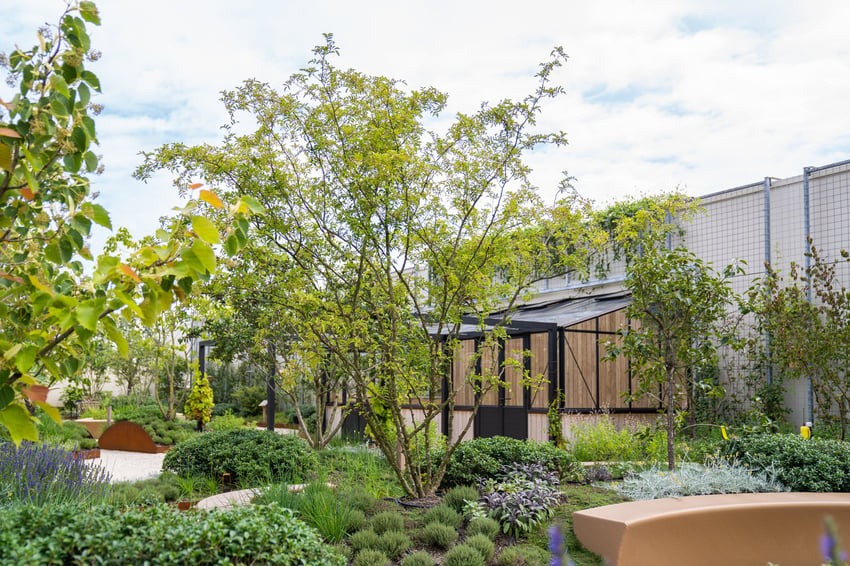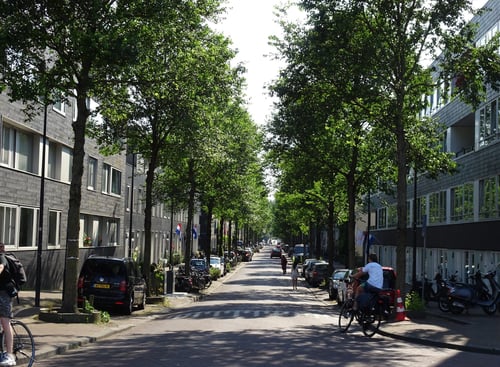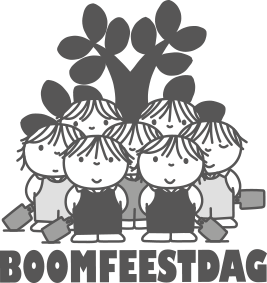The food forest: an edible ecosystem for the future

We can't ignore it these days: the edible (forest) garden is a trend. Among other things, we see this reflected in the growing need for plantings with edible fruits, both for private gardens and public spaces. The need for connection between people, nature and edible greenery seems stronger than ever.
But what is the secret behind the growing popularity of food forests, and what exactly is a food forest? How does a food forest contribute to a more healthy and biodiverse environment? In this blog, we address these questions and more.

What is a food forest?
A food forest, also called an edible forest garden, is a diverse, multilayered agro-ecosystem designed by humans to mimic the structure and functions of a natural forest, taking advantage of its ecological principles. As many trees, shrubs, climbers, herbaceous plants and roots as possible are planted together - edible for people or otherwise indirectly supporting the food forest.
All these plants complement each other, helping each other grow, forming a small-scale ecosystem that is self-sustaining and functions without external inputs such as manure and pesticides. The plants in a food forest grow largely intermixed. Depending on the purpose of the food forest, few parts contain only one species. In fact, high diversity makes for a healthy ecosystem (1).
In a broader context, permaculture is the overarching philosophy and methodology (design system) under which agroforestry and food forests fall. Permaculture is not only about food production, but also about water management, housing, energy and social structures, among others, following the ethical principles of caring for the earth, for each other and sharing together. Agroforestry is an agricultural technique that combines trees and shrubs with crops and/or livestock. This can fall under permaculture if the principles are followed, but can also be applied in modern large-scale agriculture. A food forest can be seen as a form of agroforestry, with an even stronger ecological angle. But both seek to harness ecological processes such as shade, soil improvement and biodiversity. Different crops and plants are combined to create natural habitats.

The history of the food forest
The concept of the food forest is not new, quite the contrary: food forests are in all probability the oldest form of agriculture in the world. Century-old remains of food forest agriculture have been found in Morocco, Mexico and Indonesia. In the West, this nature-inclusive way of farming has become more obsolete over the past 100 years with the rise of modern agriculture and its technologies.
However, in several places around the world, the food forest has always retained a central role and there, food forests are also called home gardens, as they are established around the home. Researchers call these gardens multistrata systems: natural forest-inspired systems with multiple layers of planting that sequester carbon. Especially in tropical Asia and Africa, Central America and in temperate and subtropical parts of China, thousands of kilometres of such gardens can be found (2).
In the 1980s, English food forest pioneer Robert Hart created a 500-square-metre edible garden in a temperate climate; in Shropshire, England. This was an inspiration to many and one of the forerunners of today's food forest movement. From 2020, the food forest is also gaining interest in Belgium and the Netherlands (2).
The term forest gardening, food gardening, was coined in the 1980s by the same Robert Hart. He experimented with numerous edible plants, trees and shrubs in his own garden and designed one of the first food forests in Britain (2). The concept of ‘food forest’ is often associated with something very large, but food forests come in all kinds of scales: from someone's own backyard to public spaces in a city, to empty fields in the countryside. Although a food forest must be a certain size to be a self-regulating system, even smaller areas can contribute to ecosystem services such as: food for people, animals and insects, water retention, soil improvement, nitrogen fixation and wind protection. Of course, the educational function of edible planting is also very important.
The benefits of the food forest - and why is it so relevant now?
A food forest contributes an important stone to restoring nature and plays a vital role in combating climate change, says Natasja Oerlemans, food and agriculture expert. The food forest helps retain CO2, ensures healthy soil life - including through nitrogen-fixing plants and plants that focus on retrieving nutrients in the deeper soil layers - and is more resistant to weather extremes (2). During heavy rainfall, the food forest acts like a sponge; during prolonged drought, it retains water. The climate-adaptive qualities of the food forest seem promising for the future.
In order to make even more informed statements about this, there is plenty of experimentation going on with this nature-inclusive form of agriculture. From publicly accessible parks in busy cities to fields in rural areas, and from edible roof gardens to growing food in one's own backyard: there is an awful lot possible. The Wageningen University (WUR) in the Netherlands, for instance, is currently establishing its own food forest on a hectare of land on its own premises, in order to conduct even closer research into the positive effects of food forestry, including in the longer term.
Building a food forest and the importance of good design
The key elements of a well-designed food forest are found in a layered structure. This translates into a design and subsequent planting that includes not only large and smaller trees and shrubs, but also climbing plants, annual vegetables, creeping ground covers, an herb layer and flower bulbs.
Because a food forest is designed as a polyculture, diseases and pests are less likely to spread en masse, affecting crops (3). A good design provides a home for many animal species. According to Van Eck, food forests often operate with a ‘glass ceiling’ when it comes to pest control: nature itself intervenes when the pest pressure on a particular area increases, natural enemies of the pest in question are - through clever design - automatically attracted to the food forest. Patiently waiting is the biggest challenge here.
A well-designed food forest forms a self-sustaining system and can provide a variety of fruits, vegetables, nuts, herbs, mushrooms and more, while at the same time promoting biodiversity, making the soil healthier and the whole more resilient to outside influences. It is a sustainable and regenerative approach to food production: a ‘new’ way of life, which at the same time also goes far back.
So all the plants together form a complete mini-ecosystem. One cannot exist without the other. And trees also play a very essential role in this picture. With this filter in the TreeEbb, you can view tree species with edible parts.
Sources
1. Jaeger, De. L. (2023). Ontwerp je eigen voedselbos. Sterck en De Vreese.
2. Crawford, M. (2018). Praktisch handboek voedselbossen: ontwerp, aanleg en onderhoud van een eetbare bostuin. Schildpad Boeken.
3. Wouter van Eck (2024). Basiscursus voedselbossen. Groesbeek.














